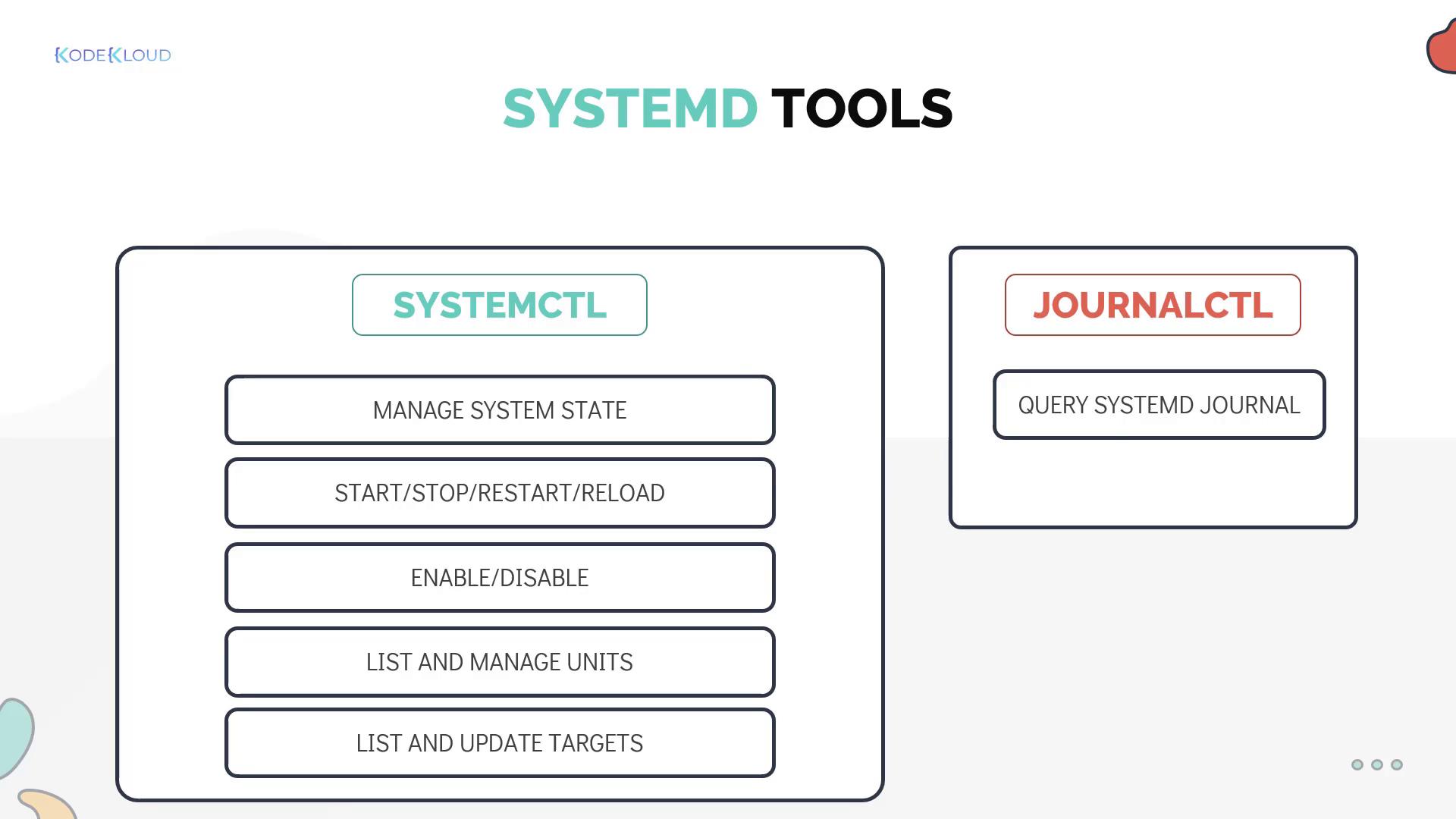Learning Linux Basics Course & Labs
Service management with SYSTEMD
SYSTEMD Tools
Now that your application is running as a service, let's explore essential systemd tools that let you manage services, work with system targets, query logs, and gather overall system state information. In this guide, we focus on two primary utilities: systemctl and journalctl.
Managing Services with systemctl
The systemctl command is the main utility for managing services on systems using systemd. You can start, stop, restart, reload, enable, disable, and check the status of any service. Previously, we demonstrated listing and changing the system's default target. Now, we will use Docker as an example service.
Common Commands
Below are some frequently used commands:
To start a service:
[~]$ systemctl start dockerTo stop a service:
[~]$ systemctl stop dockerTo restart a service (this stops and then starts the service again):
[~]$ systemctl restart dockerTo reload a service without interrupting its normal functionality:
[~]$ systemctl reload dockerTo enable a service so that it starts automatically at boot:
[~]$ systemctl enable dockerTo disable a service (preventing it from starting automatically at boot):
[~]$ systemctl disable dockerTo check the status of a service:
[~]$ systemctl status docker
The output of systemctl status docker should indicate whether the service is running as expected. For example, an "active (running)" state confirms success. Below is a sample output:
● docker.service - Docker Application Container Engine
Loaded: loaded (/lib/systemd/system/docker.service; enabled; vendor preset: enabled)
Active: active (running) since Sat 2020-03-21 00:45:22 EDT; 43s ago
Docs: https://docs.docker.com
Main PID: 23340 (dockerd)
Tasks: 18
CGroup: /system.slice/docker.service
└─23340 /usr/bin/dockerd -H fd:// --container=/run/containerd/containerd.sock
Mar 21 00:45:21 bob-Bionic dockerd[23340]: time="2020-03-21T00:45:21.628503806-04:00" level=warning msg="Your kernel does not ...
Mar 21 00:45:21 bob-Bionic dockerd[23340]: time="2020-03-21T00:45:21.628577159-04:00" level=warning msg="Your kernel does not ...
Mar 21 00:45:21 bob-Bionic dockerd[23340]: time="2020-03-21T00:45:21.629107909-04:00" level=info msg="Loading containers: sta...
Mar 21 00:45:22 bob-Bionic dockerd[23340]: time="2020-03-21T00:45:21.827198916-04:00" level=info msg="Default bridge (docker0 ...
Mar 21 00:45:22 bob-Bionic dockerd[23340]: time="2020-03-21T00:45:22.134167143-04:00" level=info msg="Loading containers: don...
Mar 21 00:45:22 bob-Bionic dockerd[23340]: time="2020-03-21T00:45:22.140095943-04:00" level=info msg="Docker daemon" commit=6...
Mar 21 00:45:22 bob-Bionic dockerd[23340]: time="2020-03-21T00:45:22.188341543-04:00" level=info msg="API listen on /var/run/...
Mar 21 00:45:22 bob-Bionic systemd[1]: Started Docker Application Container Engine.
Understanding Service States
In addition to the "active" state, be aware of:
- Inactive (dead): The service is stopped.
- Activating/Deactivating: Transitory states while a service is starting or stopping.
- Failed: Indicates an error, usually due to issues with the service's command or configuration.
Reloading Systemd Configuration
Whenever you modify a unit file, reload the system manager configuration to apply changes:
[~]$ systemctl daemon-reload
For editing unit files, you can use the systemctl edit command. For example, to fully replace the configuration for the Project Mercury service:
[~]$ systemctl edit project-mercury.service --full
After saving your changes, systemd immediately applies them without requiring an additional daemon reload.
Working with System Targets
Systemd targets (similar to runlevels) define the state of the machine. You can view or change the default target with systemctl.
To view the current default target:
[~]$ systemctl get-defaultTo change the default target (for example, to multi-user mode):
[~]$ systemctl set-default multi-user.target
Additionally, list all units (both loaded and attempted) using:
[~]$ systemctl list-units --all
A snippet of the output might appear as follows:
UNIT
network.target
nss-lookup.target
nss-user-lookup.target
paths.target
remote-fs-pre.target
remote-fs.target
rescue.target
shutdown.target
LOAD ACTIVE SUB JOB DESCRIPTION
loaded active active - Network
loaded active active - Host and Network Name Lookup
loaded active active - User and Group Name Lookup
loaded inactive dead - Paths
loaded active active - Remote File Systems (Pre)
loaded inactive dead - Remote File Systems
loaded inactive dead - Rescue Mode
loaded inactive dead - Shutdown
To view only active units, run systemctl list-units without the --all flag.
Querying Logs with journalctl
The journalctl command is an essential troubleshooting tool for querying the systemd journal logs. By default, running journalctl displays all log entries from the oldest to the newest.
To view logs for a specific unit, such as Docker:
[~]$ journalctl -u docker.service
A sample output may look like:
-- Logs begin at Fri 2020-03-13 19:47:51 EDT, end at Sat 2020-03-21 02:29:48 EDT. --
Mar 19 17:43:21 systemd[1]: Starting Docker Application Container Engine...
Mar 19 17:43:22 dockerd[2590]: level=info msg="Starting up"
Mar 19 17:43:22 dockerd[2590]: level=info msg="ClientConn switching bal"
Mar 19 17:43:22 dockerd[2590]: level=warning msg="[graphdriver] WARNING"
Mar 19 17:43:22 dockerd[2590]: level=warning msg="Usage of loopback dev"
Mar 19 17:43:22 dockerd[2590]: level=warning msg="Base device already e"
Mar 19 17:43:22 dockerd[2590]: level=info msg="Default bridge (docker0)"
Mar 19 17:43:23 dockerd[2590]: level=info msg="Loading containers: done"
Mar 19 17:43:23 dockerd[2590]: level=info msg="Docker daemon" commit=63
Mar 19 17:43:23 dockerd[2590]: level=info msg="Daemon has completed ini"
Mar 19 17:43:23 dockerd[2590]: level=info msg="API listen on /var/run/d"
Mar 19 17:43:23 systemd[1]: Started Docker Application Container Engine.
Tip
Using journalctl can help diagnose configuration issues or failed services by providing detailed log entries.

Conclusion
With the commands and examples provided above, you now have a solid foundation in managing services with systemctl and troubleshooting them using journalctl. Bob's working Project Mercury service on his laptop is just one example of how systemd can simplify system administration tasks.
Practice these commands further by creating your own systemd service and applying these management and troubleshooting techniques.
For additional resources, consider exploring:
Watch Video
Watch video content
Practice Lab
Practice lab